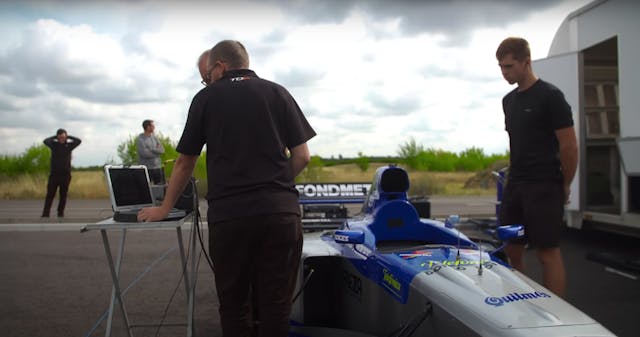Media | Articles
6 (not at all simple) steps to start a V-10 F1 car
We drivers have been spoiled ever since Charles Kettering brought forth a practical self-starter in 1911. Over the last 111 years, it has only gotten easier to start a car.
Well, most cars. Race cars are still quite complicated. For example, we found a video from Matt Amys that outlines the starting process for a late ’90s Formula 1 car. Let’s just say it is a process.
The key thing to remember is that F1 cars are designed to extract every bit of performance possible from all their components—drivelines, aerodynamics, tires, brakes. Their extreme specialization often means designing the engine and gearbox to operate within a very small window of ideal conditions.
Let’s start with engine temperature. As pointed out in the video, the tolerances of this V-10 are incredibly tight but not so finicky that the engine will not turn over when cold, as some may have heard. Running this engine outside of operating temp will greatly accelerate wear of its internals, though, just as it does for any engine.
Marketplace
Buy and sell classics with confidence
With no thermostat in the cooling system to aid in a quick heat-up, a external heater and circulation pump must heat the coolant and push it through the coolant passages, slowly bringing the engine up to ideal temp before anyone thinks of putting spark to mixture or turning the crank.
Once everything is up around 120 to 140 degrees Fahrenheit, one pit crew member can spin over the engine by hand using a breaker bar with a long extension keyed into the tail of the transmission. This gets oil circulating, pumping into all the nooks and crannies where it will be needed upon startup.
Nearly all of the systems and controls on an F1 car are hydraulic. Before fire-up, an external pump is connected to each system to flush fresh fluid in and bleed any air out. Then each system is checked for proper movement, using that external pump, to ensure it will work properly when the engine starts and becomes its own hydraulic pump. No one wants to be surprised that the clutch or throttle is not working or stuck after start up.
Are we there yet? No.
In fact, the process becomes even more complicated. A computer must come out of the toolbox and be hooked up. That computer allows the technicians to examine the temperature and function of nearly every part of the car—think on-board diagnostics, taken to a whole new level.
This particular F1 car is from 1998 and therefore presents an interesting problem: The computer needs to be of appropriate vintage or the car and computer will not play nice. A newer computer than the one used—which runs Windows 95, for reference—would read and write too fast for the hardware installed in the car.
While one tech is doing final computer checks and setting the engine mapping, another is filling the on-board compressed air bottles. This air is for the pneumatic valvetrain and needs to be topped up or else the valves will not open and close correctly. Then another external power pack is connected to prime the fuel system. The engine will turn the mechanical fuel pumps once it’s running, but to get the engine fired requires fuel pressure provided by the external pack.
We are now, finally, at the point where the starter is connected to the transmission. After someone presses the button, the engine roars to life and the car can go out on track. It needs to get to work quickly: if it sits in the pits too long, running without the airflow provided at-speed, the engine and transmission will likely overheat. This whole 1.5-to-2-hour song and dance needs to be timed nearly down to the minute on race days.
It’s certainly involved, watching the process has crushed our dreams of buying a V-10-era F1 car—something a bit more accessible than this 2010 one raced by Michael Schumacher—and turning it into a track-day toy. A Miata with a set of nice tires and brakes isn’t nearly as sexy, but at least that it doesn’t require three engineer friends to get out on track.
Check out the Hagerty Media homepage so you don’t miss a single story, or better yet, bookmark it.











Interesting. I thought there’d be more magic but it’s all pretty straight forward.